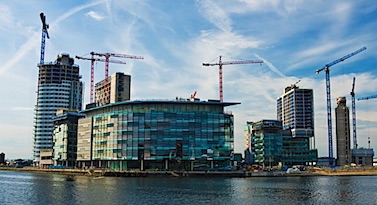The UK economy is expected to strengthen over the coming months but the economic imbalances between the North and South of England will widen between 2020 and 2023 unless a new approach to policy is adopted, reveals EY’s Regional Economic Forecast.
However, the report forecasts Manchester will be the UK’s fastest growing city between 2020 and 2023.
“The report shows that despite efforts to tackle the North-South imbalance, the share of the UK economy accounted for by the four most southerly regions of England increased from 60% to 63% between 1997 and 2019,” said EY.
“This trend is set to continue: London, the South East and the East of England will be the three fastest growing regions while the North East, Yorkshire and the Humber and the South West, will be the slowest growing locations.”
EY’s fifth economic forecast for England’s regions, cities and towns warns that imbalances in growth between different places within regions will also continue to increase, with larger cities pulling further away from towns and other smaller neighbours.
Gross Value Added (GVA) in the largest cities in England is expected to grow at 2.2% annually on average compared to growth of 1.6% for towns.
Mark Gregory, EY UK’s chief economist, comments: “Encouragingly there appears to be a strong consensus that regional disparities need be addressed.
“But our forecast shows the scale of the task facing Government in seeking to ‘level up’ the country and just how important the policy announcements in the Budget will be.
“Despite the launch of at least 40 geographic policy initiatives over the last five decades, the UK remains one of the most regionally unbalanced developed economies.
“Recent city centric initiatives such as the Northern Powerhouse and Midlands Engine have been successful in boosting the economic performance of some locations, but the impact has not been felt across the whole country.
“If we are to succeed in ‘levelling up’ the economy, a more radical and segmented approach is now urgently required.”
EY’s analysis shows that between 1997 and 2019 towns and communities in England grew 1.8% – a sixth slower than the rate achieved in the larger cities and way behind the 3.2% achieved by London and the 3% of Manchester.
Towns in the North East and Yorkshire and the Humber grew at 1.4% annually during the period, and those in the East Midlands by 1.7% – the three worst performing regional groups.
The UK’s fastest growing cities between 2020 and 2023 are forecast to be Manchester 2.2%, Nottingham 2.1%, Bristol 2% and Cambridge 2%. Reading is also identified as a fast-growing location at 2.2% GVA.
Debbie O’Hanlon, EY Managing Partner, UK Regions, comments: “The geographic imbalances in the UK are long-standing and it’s clear that there is no silver bullet or easy solution.
“This will take concerted and integrated policy thinking by government, as well as business, academia, and other stakeholders.
“Collaboration is vital and we must all be committed to supporting attempts to maximise the opportunities and performance in all parts of the country.”
